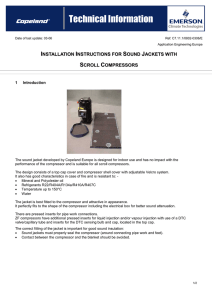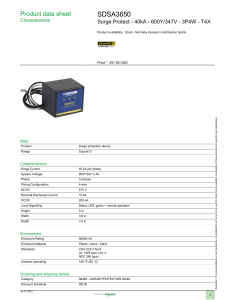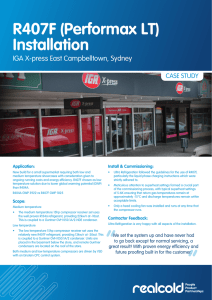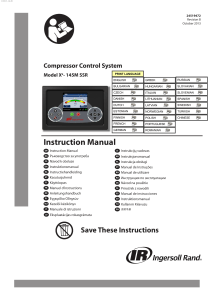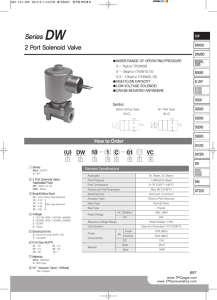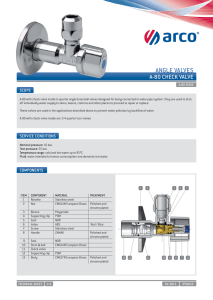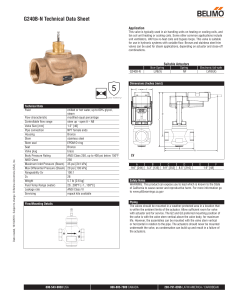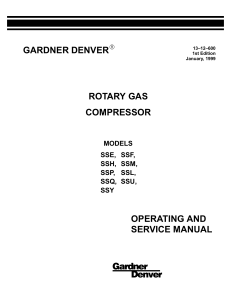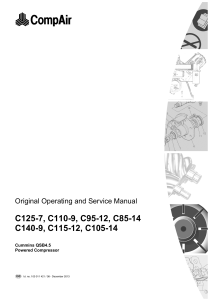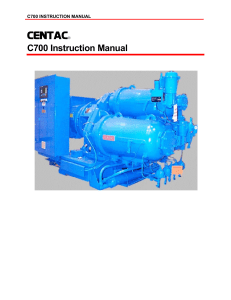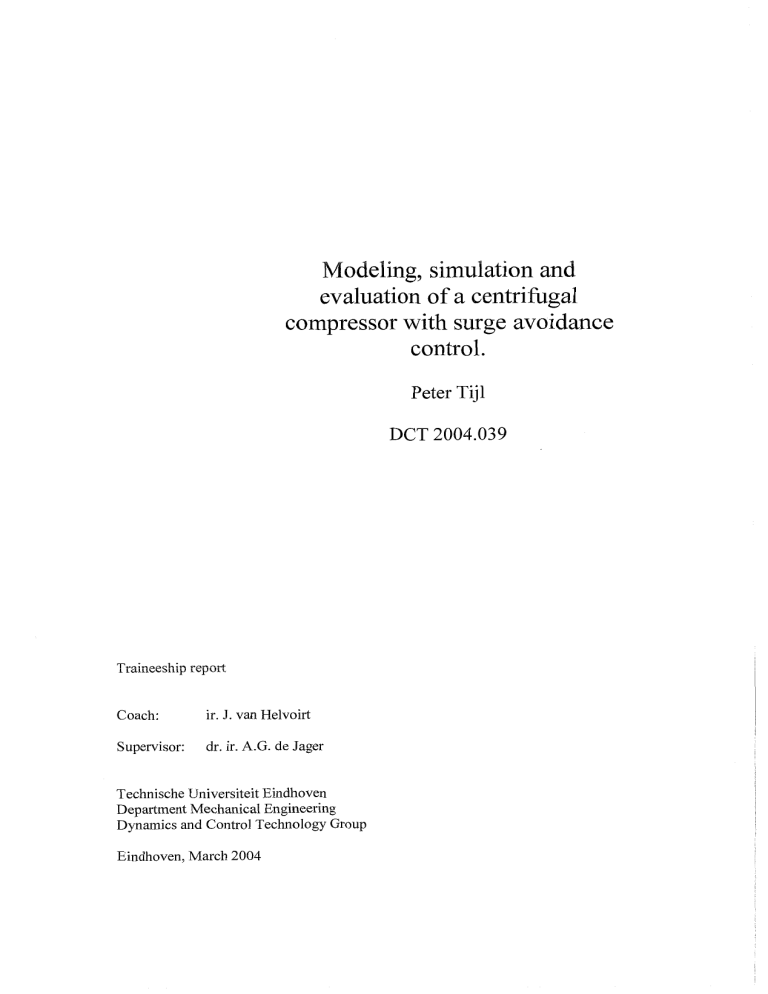
Modeling, simulation and
evaluation of a centrifugal
compressor with surge avoidance
control.
Peter Tijl
DCT 2004.039
Traiaeeship report
Coach:
ir. J. van Helvoirt
Supervisor:
dr. ir. A.G. de Jager
Technische Universiteit Eindhoven
Department Mechanical Engineering
Dynamics and Control Technology Group
Eindhoven, March 2004
Table of contents
1
Introduction
2
Compression system components
2. I
Compressor
2.2
Orifice
2.3
Controller
2.3.1 Differential action
3
2.4
Confrol valve
2.5
Disturbances
2.6
Plenum
2.7
Totalsystem
Simulation
3.1
Approach
3.2
Results
References
Nomenclature
I
Introduction
In order to obtain natural gas from a well, it is necessary to pump it to the surface and
into a network. The pump normally used in this case is a centrifugal compressor. Besides
the pressurization and transportation of fluids in the process and chemical industries,
other appiications of centrifugai compressors invoive fiuid compression for use in aircraft
engines, in industrial gas mbines and in nubocharged combustion engines j i j. The
working principle of a centrifugal compressor is to increase the kinetic energy of the fluid
with a rotating impeller. The fluid is then slowed down in a volume called the plenum,
where the kinetic energy is converted into potential energy in the form of a pressure rise.
Centrifugal compressors have an instable working region. In this region, a decrease of
flow results in a decrease of outlet pressure. When the plenum pressure behind the
compressor is higher then the compressor outlet pressure, the fluid tends to reverse or
even flow back in the compressor. As a consequence, the plenum pressure will decrease,
inlet pressure will increase and the flow reverses again. This phenomenon, called surge,
repeats and occurs in cycles with frequencies varying from 1 to 2 Hz. Another
aerodynamic instability that can occur in centrifugal compressors is stall. Both
instabilities dramatically decrease the efficiency and severe surge can even cause
mechmical danage to the compressor. In the case study of this internal traineeship, stall
is not taken into account and all attention is focused on avoiding surge.
A commonly used method to avoid compressor surge, is to recycle part of the pressurized
fluid fiom the compressor outlet back to the compressor inlet. This decreases the plenum
pressure and increases the flow through the compressor, resulting in stable working
conditions. The amount of recycled fluid is determined by the position of a control valve.
A schematic flow sheet (top) and the corresponding block scheme of the signals in the
total system (bottom) are shown in Fig 1.1.
control
valve
natural
gas well
disturbances
U
sensor
Figure 1.1 Flow sheet (top) and block scheme of signals (bottom) of the system.
The specific compression system with corresponding surge avoidance controller in this
case study is designed by Siemens Demag Delaval Turbomachinery B.V. to obtain
natural gas from a well. It is desirable to predict and perhaps modify the behavior of the
compressor with surge avoidance control. Therefore, the objectives of this internal
traineeship are:
1. Development of a simulation model of a centrifugal compressor with surge
avoidance control, based on experimental data.
2. Give a qualitative evaluation of the behavior of the modeled centrifugal
compressor and surge avoidance controller for various disturbances.
2
Compression system components
Before we make a model of the components, its function and working principle are
considered. In this chapter the compression system components (these are: compressor,
surge avoidance controller, orifice and control valve) will be treated in terms of:
Working principle
Function
Modeling
2. I
Compressor
Working principle
In general, the centrifugal compressor consists of a stationary casing, containing a
rotating impeller that imparts a high velocity to the fluid, and a number of fixed diverging
passages in which the fluid is decelerated with a consequent rise in static pressure in the
plenum. The latter process is one of diffusion, and thus the part of the compressor
containing the diverging passages is known as the diffuser. Fig. 2.l(a) is a sketch of a
centrifugal compressor. The impeller may be single- or double-sided as in 2.l(b) or 2.l(c)
but the working principle is the same. Fluid enters the impeller eye and is whirled around
at high rotational speed by the vanes on the impeller disc. The static pressure rise is
obtained in the diffuser, where the very high velocity of the fluid, leaving the impeller tip,
is reduced to a velocity similar to the velocity of the fluid entering the impeller eye.
$1
i ~ '
{d;
Figure 2.1 Sketches of centrifugal compressors [I].
Function
The function of a compressor is to pressurize a fluid. The compressor characteristics are
visualized in a so-called compressor map. In this compressor map, curves relate the
and the volume flow (Q,) through the
rotational speed (N)to the outlet pressure (PI)
compressor. A schematic representation of a compressor map is shown in Fig. 2.2.
surge
line
-cliroP
-D-
avoidance
line
stonewall
line
Figure 2.2 Schematic representation of a compressor map.
At high flows, the operating region is bounded by the stonewall line. Here, the flow in the
compressor locally reaches a Mach number of one, causing the flow to choke. The load
line is the characteristic of the resistance that the pressurized fluid encounters behind the
compressor. The intersection of the load line and the compressor characteristic for a
d Y
nrccess. The
specific W is the opemting point of the combin&ion of co~presser2 ~ lead
surge line connects points from whereon surge can occur. Though briefly mentioned in
the introduction, a more detailed description of surge with use of the compressor map is
provided here. Surge is associated with a drop in delivery pressure, and with violent
aerodynamic pulsations that are transmitted throughout the whole machine. It may be
explained as follows. If we suppose that the compressor is operating at some point on the
part of the characteristic having positive slope, then a decrease in flow will be
accompanied by a fall of delivery pressure. If the pressure of the fluid downstream of the
compressor is higher, the fluid will reverse and flow back in the compressor. When this
occurs, the pressure ratio drops rapidly. Meanwhile, the pressure downstream of the
compressor has decreased as well. The compressor will now be able to pick up again to
repeat the cycle of events resulting in oscillatory behavior. As visualized in Fig. 2.2, the
part left of the surge line has positive slope and this is the region where surge can occur.
A
A safety margin is taken into account, resulting in a new line called the surge avoidance
line. The task of the surge avoidance controller is to prevent the compressor from
operating in a point in the compressor map that is located to the left of the surge
avoidance line.
Modeling
Although the behavior of a centrihgal compressor is not constant in time, as a first
approximation a quasi-staiiunizi-yiaodel is derived. The rrsed qxisi- statioaary mde! c a ~
be extended later, or it can be replaced by a dynamic model [2].The aim is to develop a
model with flow as input and pressure rise as output. Density and temperature are
assumed to be constant throughout the whole system. Flows will be expressed as volume
flows in m 3 h and pressures will be absolute pressures in bar. The compressor
characteristics can be approximated with 3'" order polynomials for each line of constant
rotational speed N, according to:
A set of manufacturer data in the form of points on predicted performance cusves - the
compressor is not build yet - is used to derive an approximation of the quasi-static
compressor characteristic. Six curves are described by fitting a 3rdorder polynomial
through seven points for each curve. A curve corresponds with a specific rotational speed,
expressed as a percentage of the nominal rotational speed (12200 rpm). Linear
interpolation of the polynomial coefficients in (2.1) is carried out to obtain an
approximation of the intermediate curves. Since the goal of the surge avoidance strategy
is to stay in the stable operating region of the compressor, only this region of the
compressor map is approximated. The compressor output data ( H ) in (Wlkg) is converted
into absolute output pressure P2 (bar) by
with
PI = 38.2 (bar)
Z =0.92 (-)
M = 18.42 (kglmol)
TI = 30.0 ("C)
kl = 1.45 (-)
The result of the 3'* order polynomial fits is the approximated compressor map that is
displayed in Fig. 2.3.
Figure 2.3 Approximated compressor map; the solid thin lines are characteristics for constant rotational
speed, the solid fat line is the surge line, the dashed line is the surge avoidance line, the dasheddotted line is the stonewall line, the dots are data points and the square is the design point.
2.2
Orifice
Working principle
The flow measurement is based on the installation of a flow restriction named 'orifice'.
The installation of the orifice causes a static pressure difference between the upstream
side and the throat. The flow can be determined from the measured value of this pressure
difference and fi-om the knowledge of the characteristics of the fluid and the
circumstances under which the device is being used. A technical drawing of a nozzle is
shown in Fig. 2.4. The nozzle to be modeled is described in [3].
Figure 2.4 Schematic of ISA 1932 Nozzle [3].
The mass flow Q, (kg/s) can be determined via equation (2.4)
Parameter C is a function of Q,, however in this case except for Q, (kgls) and A P (Pa),
all parameters are assumed to be constant.
Function
The function of an orifice is to apply a resistance resulting in a pressure difference form
which the flow can be calculated. Together with the pressure sensors and the signal
processing hardware it is a flow measuring device and the measurement signal serves as
the controller input.
Model
The aim is to develop a model with volume flow Q, as input, and pressure difference dPl
(mbar) as output. Since density p is constant and (2.4) is in SI units, the desired
relationship between input and output is described by
The following values are obtained fiom [9] and [I 01.
d = 0.10435 (m)
/3= 0.41004 (-)
e = 0.98217 (-)
C= 0.995 (-)
p = 35.769 (kglm3)
The resulting orifice characteristic, used in the model is shown in Fig. 2.5.
I
I
I
1DUD
1500
I
20DU
a, (m3/h)
Figure 2.5 Characteristic of nozzle as described in [3].
I
I
2500
30UO
2.3
Controller
Working principle
The controller has an input signal in the form of an error and an output signal between
zero and unity, that is fed into the anti surge valve. The error e (controller input) is
calculated by
Here, Spin,,is an increase in setpoint (SP) when an additional differential action is
incorporated. This differential action will be treated in paragraph 2.3.1, for now we
assume there is no differential action and Spin, = 0. The process value (PV) is a function
of the measured pressure difference over the orifice dPI and the compressor in- and outlet
pressures PI and Pz. The PV represents the momentary operating point on the compressor
characteristic and is defined by
Here cs is a tuning parameter with a default value of 1.1467. When the compressor is at
the most right point in the characteristic, on the stonewall line, P V is at its maximum
value (PV,,). The value of PVwhen the compressor is just in surge is the Surge Point
Value (SPV). To create an anti surge margin, the value of SP is determined by
The default value for c,, is 1.21. The relation between these values and the compressor
map becomes clear from Fig. 2.6. From (2.8) we see that PVis equal to dPl divided by a
pressure. The value of dP1 corresponds to a volume flow, since dPr and Qvare directly
related via the orifice characteristic. Looking in the compressor map, dividing a flow by a
pressure, results in tan($ with a the angle between the PV-line and the vertical axis, as
displayed in Fig. 2.6 where the relationship between PV, SPV and SP lines and the
compressor map is presented.
Figure 2.6 Schematic representation of the compressor map.
Function
The objective of the controller is to keep the compressor operating in the stable region of
the compressor map, with an extra margin for safety reasons. When operating in the
stable region right from the SP-line, where the error e is positive, the controller output is
forced to zero and integrators should be reset to avoid wind-up. As the flow decreases
due to a disturbance, P V decreases as well and at a certain point where P V < SP, the error
e becomes negative. Here the controller comes into action, opening the anti surge valve.
This action 'pushes' the PVback to the stable region at the right-hand side of the SP-line.
Modeling
The discrete controller is designed by Siemens and described in [7]. The relation between
the controller output y and the input e is
With k the discrete time step, T, the sample time and Kc and INT are tuning parameters. In
order to specify these tuning parameters, a continuous transfer function is derived. First, a
z-transformation is applied to (2.10) resulting in
The discrete transfer function is
To c m v e r t the discrete transfer function into a continuous one, the matchedpole zero
(MPZ) method is used [I I]. Therefore, (2.12) is represented in a general form according
to
The general continuous transfer function is
Matching the pole and the zero respectively yields
Combining (2.12), (2.13) and (2.15) results in
Further evaluation of (2.16) and using a Taylor first order approximation leads to
From (2.16) and (2.17) the resulting continuous pole and zero are respectively
and
1
axINT
The Final Value Theorem needs to give equal results for both the discrete and the
continuous transfer functions, resulting in
Combining (2.14), (2.18) and (2.19) results in the standard expression of a continuous PI
controller
From (2.20) it becomes clear that the parameter Kc is the proportional gain and INT is the
time constant. The default parameter values used in [7] are: Kc= 4, INT = 25 and T, =
0.05 (s). With these parameter values, the Bode plots of both the discrete transfer function
(2.12) and the continuous transfer function (2.20) are created and shown in Fig. 2.7.
Frequency frwdkec)
Figure 2.7 Bode plots of the discrete and the continuous controller transfer function.
1
The breakpoint is located at a = -= 0.04 rad/sec and the discrete transfer function is
INT
cut off at the Nyquist frequency, calculated in (2.21)
2.3.1 Differential action
Besides a proportional and an integral action, a differential (D-) action can be applied.
The D-action is incorporated by changing the setpoint due to a change in flow (dF/dt).
When the flow decreases rapidly (dF/dt << 0), the danger exists of the compressor going
in surge. Therefore, the original setpoint (SP) is increased with Spin,,.As a consequence,
the PV-line passes the SP-line earlier. The controiier wili react earlier and have a kigher
output, resulting in an increased control effort.
The parameter that determines the influence of dF/dt is a weighing factor, called ci,,,. The
value of this factor depends on PV/SP, and is calculated according to (2.22). Fig. 2.8 is
displayed to visualize the effect of PV/SP on Cificr.
for
By default, the values are:
cincr,def
=
PVISP < c,
0.07
C(j = 2
C7 = 4
Figure 2.8a) Relation between PV/SP and cine,.
So the smaller PV/SP, the more important the D-action will be due to a higher value of
the weighing factor ciECr.
The effect of the D-action due to a decrease in flow is the
increase in setpoint, resulting in a negative error earlier than without D-action, as
visualized in Fig. 2.9.
Figure 2.9 Effect of the D-action is an increase in setpoint due to a decrease in flow.
2.4
Control valve
Working principle
The anti surge valve is a fail open solenoid valve. This means that it needs a high signal
of 20 mA to close the valve, and a low signal of 4 mA to open the valve. When some
failure occurs, the valve will usually receive a low signal and it will open, which is the
safe position.
Function
The control valve is the actuator of the system. When opened, it directs the pressurized
fluid fkomjust behind the m q r e s s e r bslck t~ the efitrance of the compressor. This
prevents the flow from becoming too low at the compressor inlet and decreases the
plenum pressure directly behind the compressor.
Modeling
The flow through the valve Q,, depends on the valve position u (-) and on the pressure
difference over the valve A P (bar). The relationship between these three parameters is
given by (2.23) and visualized in Fig. 2.10.
with:
p
= 35.769
d
= 0.0135
(kg/m3)
(m)
cv= 77 (-)
QW
Figure 2.10 Characteristic of solenoid valve at u = 1.
2.5
Disturbances
In order to evaluate the controller behavior, different disturbances are applied on the
model. Disturbances that could be encountered in reality are a (partial) shut down of the
process consuming the compressor flow or a variation of the composition and thus
molecular weight of the working fluid. In this case we only consider the partial shutdown
of the process behind the compressor, resulting in a change in load and in operating point
of the compressor. All simulations start in the stable region, in the design point of the
compressor. Three situations are described:
a) a step to a point in the stable region.
b) a step to a point between the actual surge line and the surge avoidance line.
c) a step to a point in the instable region.
The new operating points of the compressor, caused by disturbances, are shown in Fig.
2.11.
Figure 2.11 The design point and three operating points due to disturbances.
Modeling
The load line is modeled as a throttle valve with a very horizontal characteristic. The
valve coefficient is varied, resulting in different load lines, with different intersections
with the compressor characteristic (operating points). The relation between flow and
pressure is given by
For the design point and the three cases, the coefficients are given in table 2.1.
Table 2.1 Throttle valve coefficients for the three working points.
working point
Chad
design point
1100
a
600
b
500
c
400
2.6
Plenum
The plenum is the volume between the compressor outlet and the control valve. When the
control valve is opened, the stream splits into two parts. One is being recycled into the
compressor inlet, the other is going towards the throttle valve. A schematic representation
of the plenum is shown in Fig. 2.12.
compressor
I
A,
I
Figure 2.12 Schematic representation of the plenum.
In order to describe the dynamics of the fluid in the plenum, the conservation of mass of a
Newtonian fluid is considered [6].
Integrating over the control volume Vpand using Gauss' theorem leads to
Furthermore, isentropic compression is assumed, yielding
and
Where a is the velocity of sound
Combining (2.26) and (2.28) leads to
Converting mass flow to volume flow yields
In the final equation the factor
---
1
can be considered as - ,with r the time constant
3600V,
z
of this first order system. Increasing the time constant (this corresponds to a larger
volume), makes the system sluggish. The value of the velocity of sound a is about 370
mls. Density is assumed constant with a value of 35.8 kg/m3. A reasonable estimate of the
total volume behind the compressor is 1 m3, this leads to a time constant z = 7.345e-4 s.
When all dynamics are taken into account, with for instance the Greitzer [2] model, the
time dependant behavior of the compressor can be described. Here, only the dynamics
due to the plenum are considered. This means the time scale is too small in comparison to
the Greitzer model and reality. Another value of the time constant is chosen to make
simulations possible with a sampling time equal to that of the PLC of the controller in
reality. This sampling time is 0.05 s and the time constant has a value of z = 100 s.
Although the timescale of the simulation is not correct, this approach does result in a
representation of the general behavior of the total system.
2.7
Total System
Combining all compression system components results in the total system. A schematic
representation is shown in Fig. 2.13.
Figure 2.13 Schematic representation of total system.
In paragraph 2.3 the Bode plot of the modeled controller block is presented. In Fig. 2.14
the Bode plot of the linear time invariant process model block is shown, linearised round
the design point (Qvo,Pzo) = (2476 ,95.07)
Frequency (redlsec)
Figure 2.14 Bode plot of the linearised, time invariant process model
From Fig. 2.14 we can conclude that the process has first order low-pass behavior. The
continuous approximation deviates from the discrete bode diagram near the Nyquist
frequency, this is due to numerical effects. The bandwith of the process is 40 radlsec or
6.37 Hz. With models for both the controller and the process, the open-loop and closedloop behavior can be derived from (2.32) and (2.33), yielding
The open-loop model is used in chapter 3.2 to evaluate the stability of the closed-loop
system with Nyquist plots.
3
Simulation
In this chapter we discuss the approach of the simulations and present the results with
additional comment.
3.q
Approach
First the goals of the simulations have to be set. Several cases are simulated to provide an
answer to these four questions:
does the controller work?
what is the influence of the differential action?
what is the influence of limited control valve speed?
how do changes in controller settings effect the behavior of the system?
The three working points (a, b, c) as a result of disturbances discussed in paragraph 2.5,
will be applied in all cases. The simulated signals are:
compressor output pressure, Pz
compressor flow, V,,,
error, e
control valve position, u
process value, P V
setpoint, SP
The first two questions can be answered by simulating the shift in operating points with
the differential action and without the differential action (case 1). To answer the third
question, simulations for various rate limits are carried out (case 2). Finally, different
settings of the controller are simulated (case 3) to provide an answer to the fourth
question. An overview of the simulations is presented in table 3.1.
Table 3.1 Overview of simulations.
case description
With and without D-action
case nr.
1
PV>SP
a
la
I
worlung point
SPV<PV<SP
b
lb
I
PV<SPV
c
1c
3.2 Resulfs
Here the results are presented for the cases from which we can best observe the behavior
of the compressor with surge avoidance control. In these simulations, the values of
important constants are: rotational speed N = 100% of design speed (12200 rpm), inlet
temperature TI = 23 "C, inlet pressure PI = 38.2 bar, molecular weight M = 18.42
kglkrnol.
Case 1
In case 1 the influence of the D-action is analyzed.
10 1
0
I
I
I
I
I
I
I
I
I
1
2
3
4
5
6
7
8
9
I
10
time
Llllf
Figure 3.1 Case 1a: with and without D-action.
From Fig. 3.1 we can conclude that without D-action the time to steady state operation is
less then with D-action. Notice the difference in PV for both situations, in Fig. 3.2 more
signals are presented of this simulation and PV plays a role in these signals.
fl.
m
20
- - - - aff
-
-
15 10
0
I
I
I
I
I
I
I
I
I
1
2
3
4
5
6
?
!3
9
1D
Figure 3.2 Case la: with and without D-action.
In Fig. 3.2 the difference between the two situations is better observed. Recalling the
difference in PV seen in Fig. 3.1, it can be concluded fiom Fig. 3.2 that the difference in e
is mainly caused by the change in SP. Without D-action, the value of SP stays constant, e
remains positive and u remains zero, leaving the control valve closed. With D-action, the
value of SP is increased as a result of a fast decrease in flow and e becomes negative.
From this point, u has a positive output, opening the contsol valve. When the control
valve is opened, working fluid is recycled back into the inlet of the compressor,
increasing to flow through the compressor. As a result SP decreases, e increases and u
decreases as well. In the situation of a disturbance causing a shift of operating point
within the stable region, the D-action only has a negztive infl-ncms as it, opem the contm!
valve unnecessarily.
5
10
15
213
25
30
35
40
time
Figure 3.3 Case lc: with and without D-action.
In Fig. 3.3 results are presented of a simulation with a larger shift of operating point, into
the instable region. Applying the D-action in this case does prevent Q, from decreasing as
much as without the D-action.
Case 2
In case 2 the influence of the maximum opening rate of the control valve is considered.
Ideally, the valve is infinitely fast but in practice there is a maximum rate. From Fig. 3.4
we can conclude that until a certain rate limit, the only influence of a non-ideal valve is
the damping of the spike when opening. This has practically no consequences in the
behavior of the compressor. Beyond a certain rate limit the valve is too sluggish and Qv
;
,
,
,
,
,
,
,
,
,1,,,,1,,
lllCllGa>G> i3lU W l y .
105
.---._
-n
- /TI
I
1
I
I
I
aNIOJ
95 -
1
I
_--_ __-
-----.___*__
P
I
- inf
- 5
- - - - 13.5
- _ _ _ _ _ _ _ _ _ _ _ _ _ _ _ _ _ _ - _ _ I
I
I
I
I
I
I
I
I
10
20
30
40
513
60
70
80
90
I
I
I
I
I
I
I
I
I
2500 -
ion
-
1500 -
3
'---*;I
13.2 -
I
I
I
I
I
I
-
--
>-- ,
< _ - -
13
I
10
----
_ _ _ _ . - ? -
I
I
I
20
30
40
Figure 3.4 Case 2c: various rate limits (% / s).
I
50
time
I
I
I
I
60
70
80
90
7
100
Case 3
In case 3 the effect of a change in controller settings is simulated, starting with the
proportional gain Kc.
Figure 3.5 Case 3c: various values for K,.
The default value for Kc is 4 and fi-omFig. 3.5 we can conclude this gives stable
behavior. Increasing Kc is expected to make the response faster and it does. However,
beyond a value of 41 the controller output is instable, resulting in an oscillating control
valve. The stability is analyzed in the Nyquist plots in Fig.3.6.
Nyquist Diagram
E
>
3
1
I
I
L
1 I
Real Axis
Figure 3.6 Nyquist diagram for various values of Kc.
Although the simulations show instable behavior at Kc is 41, the Nyquist plot encircles
the point (-1,O) for values larger than 68. A reason for this difference could be that the
process is linearised in the design point and when oscillations occur in the simulation, the
process is no longer operating round the design point, but on the surge avoidance line.
Next, we change the value of integration time INT. The default value is 25 and decreasing
INT is expected to result a faster response. As shown in Fig. 3.7 decreasing INTresults in
a faster response, until the critical value of 0.003. Simulations with this critical value
show oscillatory behavior that damps out. Decreasing INT beyond this critical value
results in consistent instable behavior.
0
2
4
6
0
10
time
12
14
16
18
20
Figure 3.7 Case 3c: various values for N T .
In order to check if the closed loop system is instable according to the Nyquist criterion,
the Nyquist plots are presented in Fig. 3.8.
Nyquist Diagram
Real Axis
Figure 3.8 Nyquist diagram for various values of INT.
From Fig. 3.8 we can conclude that the closed-loop system becomes instable for values of
IiVT smaller then 0.0015. This corresponds with our findings from the simulations.
Finally, the effect of a change of the D-action is considered. As discussed in paragraph
2.3.1, the D-action responds to a decrease in flow. The influence of this decrease is
By default this value is 0.07, resulting in a stable
determined by the value of cifiCr.
response as observed in Fig. 3.9. Decreasing the value of cincrresultsin a slower response,
increasing leads to s faster response. As ci,,, is increased above the critical value of 0.16,
the system is instable, showing oscillatory behavior as can be seen in Fig. 3.9.
0
la
20
30
40
50
60
70
80
90
100
time
Figure 3.9 Case 3b: various values for c,,.
The D-action is incorporated in the process model block and a change in q,,,will not
controller model. Changing ci,,, does not influence the linearised model and the
.Naffect
- Y ~ the
U stability
~ S ~
criterion cannot be investigated.
4
Conclusions and recommendations
We recall the objectives of this internal traineeship from the introduction:
1. Development of a simple simulation model of a centrifugal compressor with surge
avoidance control, based on experimental data.
2. Give a qualitative evaluation of the behavior of the modeled centrifugal
compressor and surge avoidance controller for various disturbances.
The first objective is met, however the compressor model is quasi-static and it does not
represent all dynamics. We recommend making a dynamic compressor model, for
instance according to [2].The second objective is partially met. Where possible, the
behavior observed in the simulations is further analyzed with the Nyquist stability
criterion. The conclusions that can be drawn from this internal traineeship are:
Surge avoidance control is necessary, it however limits the operating range of
the compressor.
Applying the differential action gives a faster response, but can result in
undesirable opening of the control valve.
If the maximum opening rate of the control valve is too low, this will increase
the time to steady-state.
Adjusting the controller settings is bounded by the stability of the system.
Recommendations for further research are:
Development of a dynamic compressor model to evaluate transient behavior.
Investigate the effect of varying moiecuiar weight of the compressor working
fluid.
References
Saravanamuttoo, H.I.H., Rogers, G.F.C., Cohen, H. 'Gas Turbine Theory.' 2001.
Greitzer, E.M. 'Surge and Rotating Stall in Axial Flow Compressors', part I and I1
, 1976.
ISOIFDIS 5 167-3:2002(E), 'Measurement of fluid flow by means of pressure
differential devices inserted in circular-cross section conduits running h l l .
Part 3: Nozzles and Venturi nozzles.'
Willems, F.P.T. 'Modeling and Bounded Feedback Stabilization of Centrifugal
Compressor Surge.' 2000.
Nelson, E.B., Paduano, J.D., Epstein, A.H. 'Active Stabilization of Surge in an
Axicentrifugal Turboshaft Engme.' 2000.
Kundu, P.K., Cohen, I.A. 'Fluid mechanics.' , 1990
Siemens Demag Delaval Turbomachinery B.V. 'Control system72003.
Siemens Demag Delaval Turbomachinery B .V. 'Predicted performance map'
2004.
Siemens Demag Delaval Turbomachinery B.V. 'Calculation sheet of flow
measuring device. ' 2003.
Siemens Demag Delaval Turbomachinery B.V. 'Sliding stem control valve
specification.' 2003.
Franklin, G.F., Powell, J.D., Emami-Naeini, A., 'Feedback control of dynamic
systems.', 1995
Nomenclature
area
tuning constant
anti-surge margin
discharge coefficient
load line coefficient
flow coefficient
inner diameter
outer diameter
pressure difference over orifice
error
head
integration time
specific heat ratio (CJCv)
gain
molecular weight
rotational speed
inlet pressure
outlet pressure
natural gas net pressure
process value
mass flow
volume flow
volume flow through compressor
volume flow through control valve
volume flow through throttle valve
set point
surge point value
inlet temperature
sample time
valve position (openlclosed = 110)
compressibi!it.j fzcter
diameter ratio (d/D)
expansion factor
denstity
fiequency
Nyquist frequency
m
m
mbar
-
kg/krnol
%
bar
bar
bar
-
kg/m3
rads
rads
